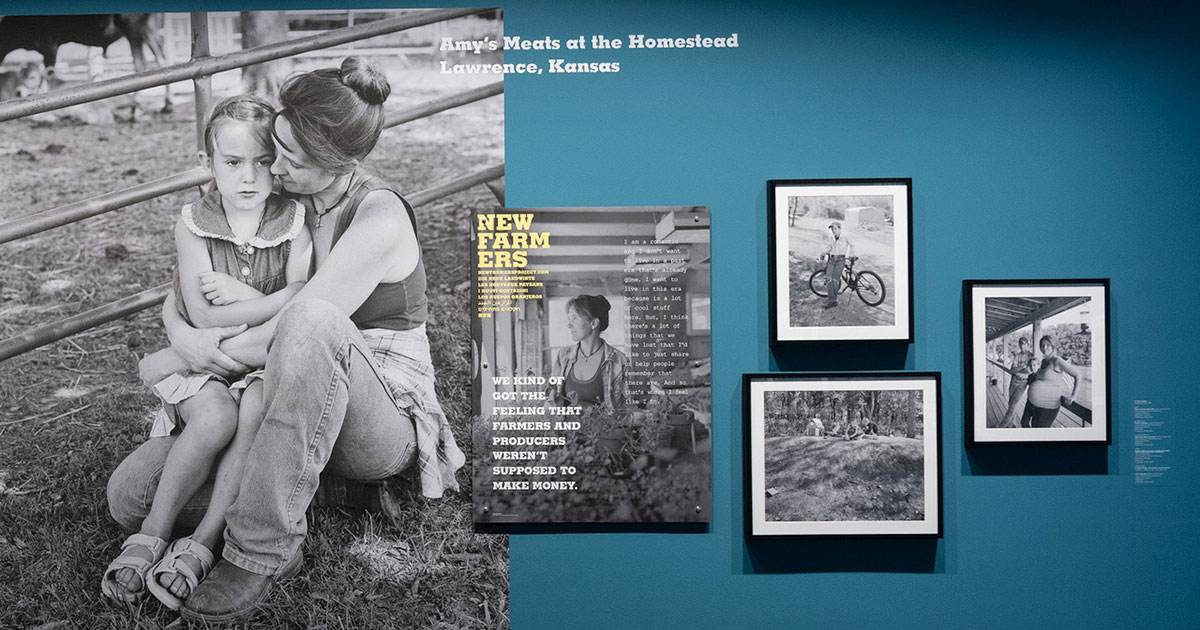New farmers tackle tough task out of love

LAWRENCE – Growing up on a farm and carrying on a family tradition is one thing. Taking on the trials of farming from scratch? That’s quite another.
The environmental and societal concerns that drive some 21st-century farm families away from cities and even divide them from their conventional-farming neighbors are the focus of the new book “New Farmers 2014/2018” (P&T Committee, 2019) created by a cross-disciplinary team of University of Kansas scholars.
The project had its genesis when Paul Stock, associate professor in the Department of Sociology and the Environmental Studies Program, met Bryon Darby, former KU assistant professor of photo media and now a lecturer in photography at Utah State University, a couple of years ago at a teaching seminar organized by KU’s Center for Sustainability.
Along the way, they were joined by Tim Hossler, associate professor of design, as designer.
Stock had just come to KU after spending years in New Zealand, studying how that South Pacific nation “went from being primarily a sheep-farming country to becoming the world's largest dairy exporter.”
“I was working on a global scale, and I wanted to do something a little different, having just moved to Kansas and back to the Midwest,” Stock said. “I was interested in studying people that were getting into farming. Farming is hard. It's hard to stay in; it's hard to make money. Everything about it is hard. So what is going on with these people that are actively trying to get into it?”
Stock recalled Darby saying, “I'm really interested in photographing these new farmers, people who are at the farmers' market. And I thought: That's what I want to do.”
They launched the project that resulted first in gallery exhibitions and ultimately in “New Farmers 2014/2018.”
Darby and Stock set out first to interview and photograph Amy Saunders of Amy’s Meats north of Lawrence.
Stock credits Darby’s method of working for helping the subjects to open up about their feelings.
“Bryon set most of these up, and he's like, ‘Can I come photograph you? And Paul's going to come along, and we're going to have a talk.’ He's using this old-style view camera, with the cloth hood over his head and the whole deal. But the real gift of it to doing research is that it takes time. People have to stay real still … which lends itself really well to interviewing. With this way of shooting, they had to relax and be vulnerable.”
Stock and Darby branched out from there to other farmers' market purveyors and beyond across eastern Kansas.
“It wasn't just young farmers, and it wasn't just brand new, because some of the people that were depicted in the book started farming 30 years ago, but they're still mentoring people,” Stock said. “We asked them about their story of becoming a farmer. What was it that brought about that change in their identity?”
More than one farm family, Stock said, had come to agriculture from teaching.
“It's not that radical a shift when you hear them talk about it, because it's all about care and giving,” Stock said.
“New Farmers” is sort of a misnomer, Stock said, in that these farmers, even if not all are certified organic, are at least engaged in less technologically intense methods of raising food than a typical Midwestern row-crop farm with thousands of acres.
“They're doing stuff that people around the world have been doing for thousands upon thousands of years,” Stock said. “The people we've spoken to are asking, ‘How do I live a good life? How do I live my best life with my family, with friends involved, with the community I care about?’ It's hard. And we’re not going to make much money. But we're going to be pretty happy and fulfilled.”
The “New Farmers” are not out trying to convert the world to their ways of thinking, living or agriculture, Stock writes in the book. They just want to be left alone to do things their own way. In this age of disputes over carcinogenic pesticides and right-to-repair-equipment laws, that may be harder than it seems at first blush.
Hossler said the combination of text and images he chose for the book “reflects a design history most notable from the Great Depression era, including photographers Dorothea Lange and Walker Evans, who worked closely with their writing collaborators. They are key examples of the book’s inspiration because of the specific combinations of text and imagery as well as the portrayal of farmers. The look of the book reflects those interests and the collaborative spirit of the project.”
Stock and Hossler said The Commons, a partnership among KU’s Biodiversity Institute, Hall Center for the Humanities and Spencer Museum of Art, and its director, Emily Ryan, played important roles in the evolution of the "New Farmers" project, including early research funding, gallery space and support for the book.
Hossler said many of the design choices reflected in the book were made when “New Farmers” started as a gallery exhibition. It returns to its exhibition form July 9-Aug. 11 for a display at the Lenexa City Hall Art Gallery.
“New Farmers 2014/2018” was recently named among the 50 best books and 50 best book covers of the year by Design Observer and AIGA, the professional association for design.
Photo: A panel from the Wichita Art Museum’s 2018 “New Farmers” exhibition featuring photographs by Bryon Darby, text by Paul Stock and design by Tim Hossler. Credit: Kirk Eck